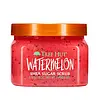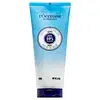What's inside
What's inside
 Key Ingredients
Key Ingredients

 Benefits
Benefits

 Concerns
Concerns

 Ingredients Side-by-side
Ingredients Side-by-side

Sucrose
HumectantGlycerin
HumectantPolysorbate 20
EmulsifyingSilica
AbrasiveActinidia Chinensis Seed
AbrasivePersea Gratissima Oil
Skin ConditioningButyrospermum Parkii Butter
Skin ConditioningCarthamus Tinctorius Seed Oil
MaskingPrunus Amygdalus Dulcis Oil
Skin ConditioningOenothera Biennis Oil
EmollientMacadamia Ternifolia Seed Oil
EmollientAloe Barbadensis Leaf Juice
Skin ConditioningCitrus Aurantium Dulcis Oil
MaskingCitrus Medica Vulgaris Fruit Extract
AntioxidantRice Amino Acids
Skin ConditioningHydrolyzed Soy Protein
HumectantProline
Skin ConditioningHydrolyzed Adansonia Digitata Seed Extract
Niacinamide
SmoothingWater
Skin ConditioningAscorbic Acid
AntioxidantRetinyl Palmitate
Skin ConditioningParfum
MaskingPhenoxyethanol
PreservativeSorbic Acid
PreservativeCaprylyl Glycol
EmollientBenzyl Benzoate
AntimicrobialCitral
PerfumingCI 14700
Cosmetic ColorantCI 17200
Cosmetic ColorantSucrose, Glycerin, Polysorbate 20, Silica, Actinidia Chinensis Seed, Persea Gratissima Oil, Butyrospermum Parkii Butter, Carthamus Tinctorius Seed Oil, Prunus Amygdalus Dulcis Oil, Oenothera Biennis Oil, Macadamia Ternifolia Seed Oil, Aloe Barbadensis Leaf Juice, Citrus Aurantium Dulcis Oil, Citrus Medica Vulgaris Fruit Extract, Rice Amino Acids, Hydrolyzed Soy Protein, Proline, Hydrolyzed Adansonia Digitata Seed Extract, Niacinamide, Water, Ascorbic Acid, Retinyl Palmitate, Parfum, Phenoxyethanol, Sorbic Acid, Caprylyl Glycol, Benzyl Benzoate, Citral, CI 14700, CI 17200
Water
Skin ConditioningButyrospermum Parkii Butter
Skin ConditioningGlyceryl Stearate
EmollientGlycerin
HumectantDicaprylyl Carbonate
EmollientCaprylic/Capric Triglyceride
MaskingSilica
AbrasiveArachidyl Alcohol
EmollientMyristyl Alcohol
EmollientCetyl Alcohol
EmollientCera Alba
EmollientJuglans Regia Shell Powder
AbrasivePrunus Armeniaca Kernel Oil
MaskingHelianthus Annuus Seed Oil
EmollientPotassium Cetyl Phosphate
EmulsifyingMyristyl Glucoside
CleansingCaprylyl Glycol
EmollientArachidyl Glucoside
EmulsifyingAllantoin
Skin ConditioningBehenyl Alcohol
EmollientXanthan Gum
EmulsifyingSodium Hydroxide
BufferingChlorphenesin
AntimicrobialTocopherol
AntioxidantParfum
MaskingBenzyl Alcohol
PerfumingBenzyl Benzoate
AntimicrobialLinalool
PerfumingCitronellol
PerfumingCoumarin
PerfumingHexyl Cinnamal
PerfumingLimonene
PerfumingWater, Butyrospermum Parkii Butter, Glyceryl Stearate, Glycerin, Dicaprylyl Carbonate, Caprylic/Capric Triglyceride, Silica, Arachidyl Alcohol, Myristyl Alcohol, Cetyl Alcohol, Cera Alba, Juglans Regia Shell Powder, Prunus Armeniaca Kernel Oil, Helianthus Annuus Seed Oil, Potassium Cetyl Phosphate, Myristyl Glucoside, Caprylyl Glycol, Arachidyl Glucoside, Allantoin, Behenyl Alcohol, Xanthan Gum, Sodium Hydroxide, Chlorphenesin, Tocopherol, Parfum, Benzyl Alcohol, Benzyl Benzoate, Linalool, Citronellol, Coumarin, Hexyl Cinnamal, Limonene
Ingredients Explained
These ingredients are found in both products.
Ingredients higher up in an ingredient list are typically present in a larger amount.
Benzyl Benzoate is usually created from the condensation of benzoic acid and benzyl alcohol. It is used as a preservative, solvent, and has a floral/balsamic scent in large amounts.
As a preservative, Benzyl Benzoate works against bacteria and fungus. It is often used to treat scabies and lice in medicine.
Solvents are used to keep ingredients together in a product. They can help dissolve ingredients to stable bases or help evenly distribute ingredients throughout the product.
Due to its fragrance, Benzyl Benzoate can be sensitizing and may cause contact dermatitis. It is a known EU allergen. We recommend speaking with a professional if you have any concerns.
Benzyl Benzoate can be naturally found in cranberries and peaches.
Learn more about Benzyl BenzoateThis ingredient is also known as shea butter. It is an effective skin hydrator and emollient.
Emollients help soothe and soften your skin. It does this by creating a protective film on your skin. This barrier helps trap moisture and keeps your skin hydrated. Emollients may be effective at treating dry or itchy skin.
Shea butter is rich in antioxidants. Antioxidants help fight free-radicals, or molecules that may harm the body. It is also full of fatty acids including stearic acid and linoleic acid. These acids help replenish the skin and keep skin moisturized.
While Shea Butter has an SPF rating of about 3-4, it is not a sunscreen replacement.
Shea butter may not be fungal acne safe. We recommend speaking with a professional if you have any concerns.
Learn more about Butyrospermum Parkii ButterCaprylyl Glycol is a humectant and emollient, meaning it attracts and preserves moisture.
It is a common ingredient in many products, especially those designed to hydrate skin. The primary benefits are retaining moisture, skin softening, and promoting a healthy skin barrier.
Though Caprylyl Glycol is an alcohol derived from fatty acids, it is not the kind that can dry out skin.
This ingredient is also used as a preservative to extend the life of products. It has slight antimicrobial properties.
Learn more about Caprylyl GlycolGlycerin is already naturally found in your skin. It helps moisturize and protect your skin.
A study from 2016 found glycerin to be more effective as a humectant than AHAs and hyaluronic acid.
As a humectant, it helps the skin stay hydrated by pulling moisture to your skin. The low molecular weight of glycerin allows it to pull moisture into the deeper layers of your skin.
Hydrated skin improves your skin barrier; Your skin barrier helps protect against irritants and bacteria.
Glycerin has also been found to have antimicrobial and antiviral properties. Due to these properties, glycerin is often used in wound and burn treatments.
In cosmetics, glycerin is usually derived from plants such as soybean or palm. However, it can also be sourced from animals, such as tallow or animal fat.
This ingredient is organic, colorless, odorless, and non-toxic.
Glycerin is the name for this ingredient in American English. British English uses Glycerol/Glycerine.
Learn more about GlycerinParfum is a catch-all term for an ingredient or more that is used to give a scent to products.
Also called "fragrance", this ingredient can be a blend of hundreds of chemicals or plant oils. This means every product with "fragrance" or "parfum" in the ingredients list is a different mixture.
For instance, Habanolide is a proprietary trade name for a specific aroma chemical. When used as a fragrance ingredient in cosmetics, most aroma chemicals fall under the broad labeling category of “FRAGRANCE” or “PARFUM” according to EU and US regulations.
The term 'parfum' or 'fragrance' is not regulated in many countries. In many cases, it is up to the brand to define this term.
For instance, many brands choose to label themselves as "fragrance-free" because they are not using synthetic fragrances. However, their products may still contain ingredients such as essential oils that are considered a fragrance by INCI standards.
One example is Calendula flower extract. Calendula is an essential oil that still imparts a scent or 'fragrance'.
Depending on the blend, the ingredients in the mixture can cause allergies and sensitivities on the skin. Some ingredients that are known EU allergens include linalool and citronellol.
Parfum can also be used to mask or cover an unpleasant scent.
The bottom line is: not all fragrances/parfum/ingredients are created equally. If you are worried about fragrances, we recommend taking a closer look at an ingredient. And of course, we always recommend speaking with a professional.
Learn more about ParfumSilica, also known as silicon dioxide, is a naturally occurring mineral. It is used as a fine, spherical, and porous powder in cosmetics.
Though it has exfoliant properties, the function of silica varies depending on the product.
The unique structure of silica enhances the spreadability and adds smoothness, making it a great texture enhancer.
It is also used as an active carrier, emulsifier, and mattifier due to its ability to absorb excess oil.
In some products, tiny microneedles called spicules are made from silica or hydrolyzed sponge. When you rub them in, they lightly polish away dead skin layers and enhance the penetration of active ingredients.
Learn more about SilicaWater. It's the most common cosmetic ingredient of all. You'll usually see it at the top of ingredient lists, meaning that it makes up the largest part of the product.
So why is it so popular? Water most often acts as a solvent - this means that it helps dissolve other ingredients into the formulation.
You'll also recognize water as that liquid we all need to stay alive. If you see this, drink a glass of water. Stay hydrated!
Learn more about Water